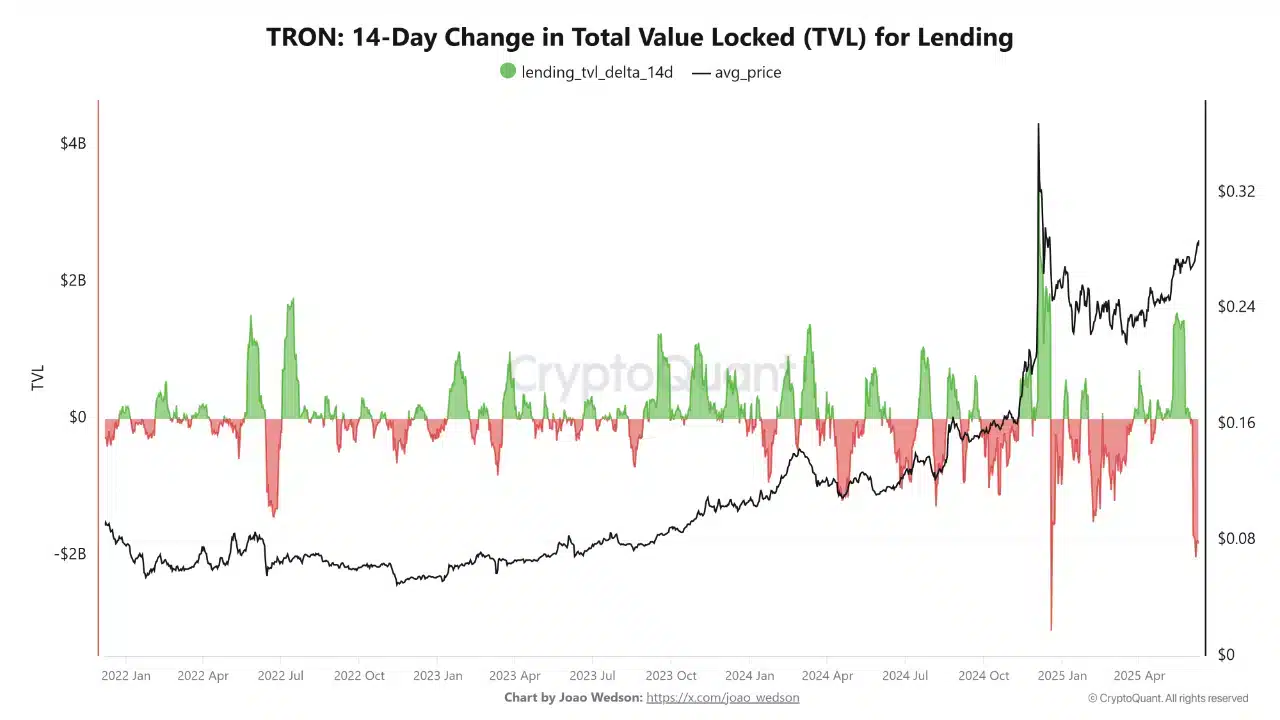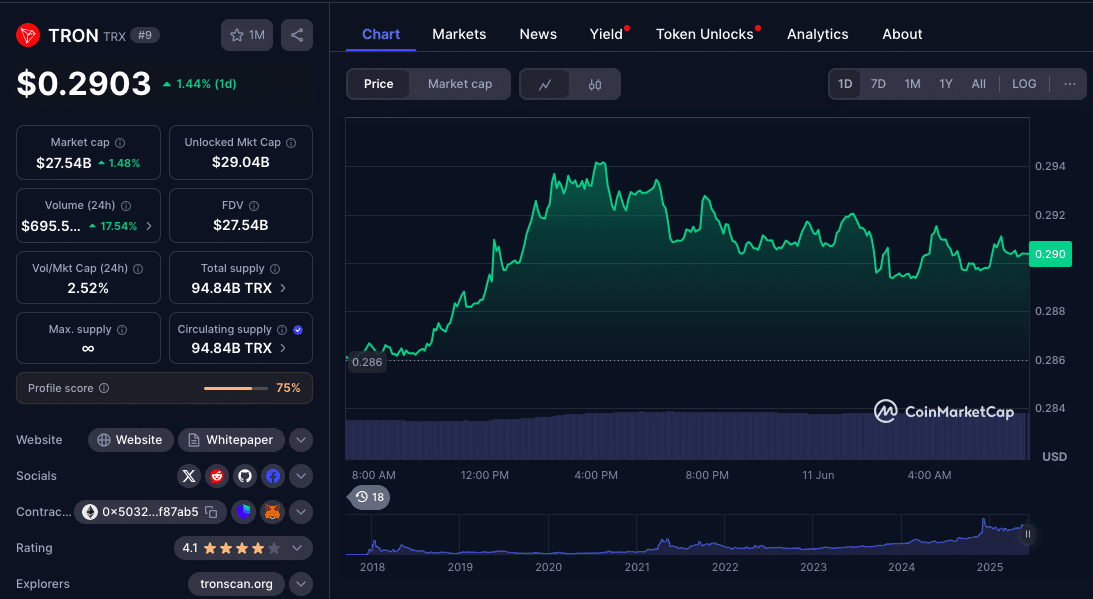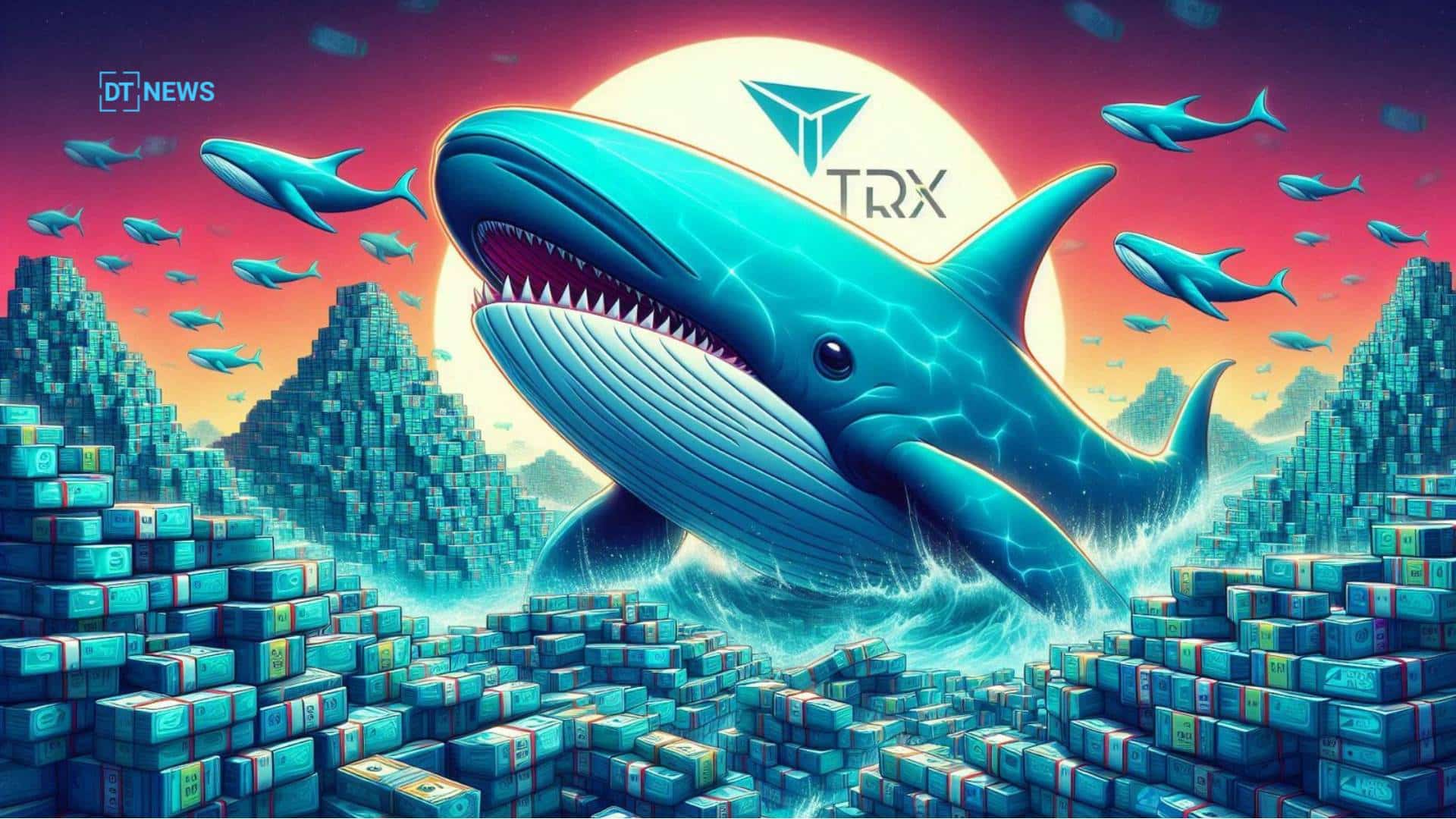TRON (TRX) is flashing mixed signals and traders are divided. On-chain metrics show accumulation and rising activity but undercurrents of declining lending and selling pressure say caution is warranted. Currently, TRX trades $0.2903. However, as the token tests the upper end of a long range, the question is no longer if TRX will move but in which direction.
- TRON Whales Tighten Their Grip as Gas Usage Hits Highs
- Lending TVL Collapse: Don’t Ignore it
- Taker Sell Pressure Puts Cold Water on Breakout Hopes
- TRX Range-Bound for Now but not Forever
- Why TRON Whales May be Preparing for Long-Term Upside
- Conclusion: All Eyes on Volume, not Just Price
- FAQs
- What does TRON’s gas usage ratio mean?
- Why is the drop in TRON’s lending TVL important?
- What does taker sell dominance mean for TRX?
- Why is whale accumulation important?
- What price must TRX break to confirm a bullish trend?
- Glossary
TRON Whales Tighten Their Grip as Gas Usage Hits Highs
In the last few weeks, TRON whales have reportedly increased their TRX holdings by over 10% while mid-tier wallets have added 41.19%. This is the same pattern seen, before previous TRX rallies and is backed by increasing network utility. TRON’s gas usage ratio, a key measure of transactional intensity has been rising since late 2024 and is in line with the price.
This alignment between on-chain activity and price is usually a good sign but history shows it doesn’t always hold. TRX has decoupled from these indicators before during times of hype or ecosystem stress. That is what makes the current signals interesting; both whales and the chain’s core utility are going up but other indicators are yellow.
Lending TVL Collapse: Don’t Ignore it
The $2 billion drop in TRON’s lending TVL over the last two weeks is opposite the price trend. This means borrower confidence is weakening, risk-off sentiment or capital is rotating out of TRON DeFi. Lending TVL is often an early indicator of internal liquidity. When users pull liquidity from lending protocols, it means they are anticipating volatility or stepping away from leveraged bets.

Note that the TVL drop is happening while TRX is testing resistance at $0.29. This is a divergence; if on-chain liquidity is declining even as the token is at the breakout level, this could be a structural weakness behind the bullish facade. Traders should watch if this outflow stabilizes or deepens.
Taker Sell Pressure Puts Cold Water on Breakout Hopes
Despite TRX being at a key resistance level, the taker volume delta over the last 90 days is still bearish. This means more aggressive selling than buying even in an uptrend.When taker activity is negative while price is up, it usually means low conviction buying. This is what has been seen in previous failed breakouts where price went up on passive flows but lacked demand to sustain the momentum. Without a reversal of this imbalance, any breakout could fizzle out as sell walls absorb thin buy interest.
This is where TRON whales become even more important. If they keep accumulating while the imbalance persists, it means they expect a delayed but stronger breakout once the market absorbs the selling overhead.
TRX Range-Bound for Now but not Forever
For nearly four months, TRX has been consolidating between $0.25 and $0.29, a narrow horizontal channel that has now become a psychological battlefield. With the RSI climbing towards 65, traders are waiting for a confirmed breakout above $0.29 with high volume.
But breakouts require more than price flirting with resistance. There must be conviction. A failure to breach with strong momentum could send TRX back into the lower band, especially if sell pressure continues and on-chain lending metrics worsen.
Still, the current accumulation by whales and rising gas usage suggests long term conviction is intact. The question is will short term headwinds such as sell pressure and TVL outflows delay or reverse the move?
Why TRON Whales May be Preparing for Long-Term Upside
While retail holders are flat, the continued accumulation by TRON whales and institutional style wallets is long term bullish. In previous cyles, strong hands buying into resistance often precedes major breakouts especially when the market is distracted or skeptical.

Moreover, with 92.39% of all TRX addresses reportedly in profit, this could go either way. On one hand, these high unrealized profits could tempt short term holders to take gains. On the other hand it could signal growing confidence as most participants feel secure in their positions and are less likely to panic sell.
If whales and mid tier investors continue to accumulate, it may mean the current consolidation is just a staging ground for a longer rally. This is especially true if lending TVL stabilizes and taker volume starts to show signs of buy side dominance.
Conclusion: All Eyes on Volume, not Just Price
TRX’s price now depends on whether it can flip $0.29 into support. The ingredients for a breakout are there: whale accumulation, high network usage and historical profit realization. But without a reversal in taker volume and a halt to the bleeding in DeFi lending protocols, TRX is vulnerable to rejection.
In short, TRON whales are betting on strength but the market needs more proof. A breakout without strong hands behind it can quickly become a fakeout. Investors and traders would be wise to watch volume, on-chain flows, and lending activity, not just price candles.
FAQs
What does TRON’s gas usage ratio mean?
It shows network activity. A rising ratio means more transactional throughput, which is often seen as bullish because it means real usage of the blockchain.
Why is the drop in TRON’s lending TVL important?
Lending TVL means capital locked in lending protocols. A big drop can mean reduced confidence, risk-off behavior or liquidity migration – all of which can kill a bullish trend.
What does taker sell dominance mean for TRX?
It means people are selling aggressively. If taker sell volume stays high, rallies may not be strong and can reverse quickly.
Why is whale accumulation important?
Whales have better access to market info and capital. Their accumulation often precedes long term price increases so their behavior is a key signal.
What price must TRX break to confirm a bullish trend?
TRX needs to break above $0.29 and hold that level with volume to confirm the breakout from the range.
Glossary
TRON (TRX): A blockchain for high speed transactions and dApps. TRX is the native token.
Whale: A wallet or entity that holds a large amount of a particular cryptocurrency and can move the market.
TVL (Total Value Locked): The amount of crypto assets in DeFi protocols. It means the overall liquidity of the ecosystem.
Taker Volume Delta: The net difference between aggressive buys and sells on exchanges. Negative delta means more selling.
RSI (Relative Strength Index): A momentum indicator to identify overbought or oversold conditions in the market.



















































































































